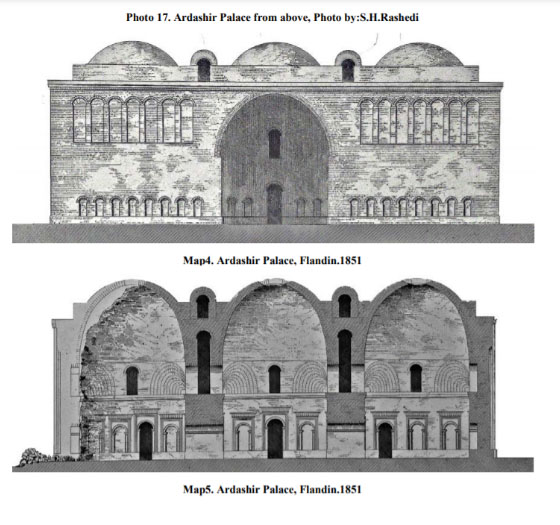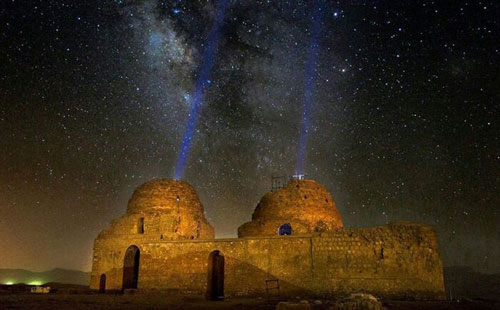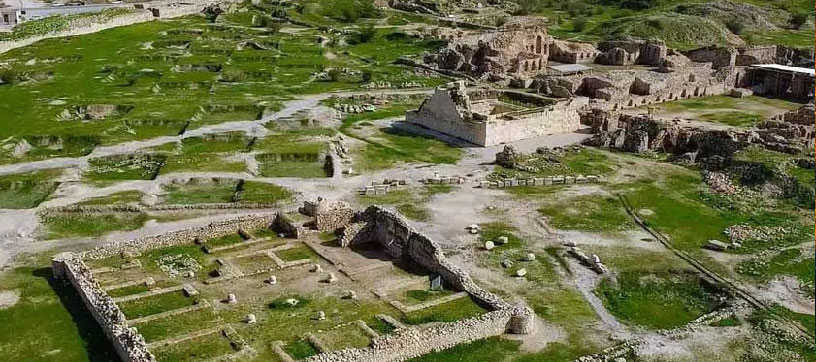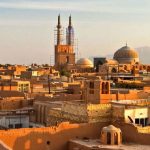Sassanid Archaeological Landscape of Fars Region
Fars province is a treasure chest of palaces, fortifications, and reliefs from the Sassanid period. In 2018, UNESCO registered eight archeological sites of this great treasure in Firoozabad, Bishapur, and Sarvestan:

Dokhtar Castle, The Oldest Domed building in the World
In Persian, called /qal-e dokhtar/
Qaleh Dokhtar (Dokhtar means girl), as a 71-hectare fortress built by Ardashir in a strategic location on three levels, dates back to 1800 years ago. Qaleh Dokhtar was created as a stronghold to protect the Sassanid capital against the Parthian King. This fortress includes a monumental palace with Chahar-Taq domes (dome on a square space), auxiliary structures, open spaces, and outer fortification walls. The entrance hall on the lower access level, vaulted halls with an intermediate terrace, and private rooms on the uppermost level are made this stone castle. Copper coins of Yazdegerd III, the last Great King of Sassanian Empire, have been excavated in the inner fortress’ walls. The castle is in mountains of Firoozabad, Fars Province.
The Victory Relief of Ardashir, The Largest Relief in Iran
In Persian, called /sang negar-e pirozi-e ardeshir/

The Sassanid reliefs in Fars were influenced by the Parthian and Achaemenid ritual and cultural traditions, and rock-caving techniques of reliefs refer to Sassanid artistic and architectural approaches. The Victory Relief of Ardashir depicts Ardashir’s victory battle against the last Parthian king with all details in 18 m length and 4 m height is located in the Tangi Ab Gorge, Firuzabad. Six warriors on horseback, Ardashir Babakan, Ardavan V (the last Parthian king) with a spear on the ground, son of Ardeshir, the minister of Ardavan, and Shapur call you in Firoozabad.

Ardashir Investiture Relief, The Relief of the kingdom of Ardeshir Babakan
In Persian, called /sang negar-e padeshahi ardeshir/
Ardashir Investiture Relief depicts Ahuramazda and Ardeshir Babakan while Ahuramazda gives the king Crown of power to Ardeshir from the altar of fire in details such as clothes and horses’ muscles. This relief, as the lithograph of the coronation of Ardeshir Babakan, is in Firoozabad.
Ardashir Babakan Palace, The largest Fire Temple in Fars
In Persian, called /kakh-e Ardeshir/ or /Atash kad-e Ardeshir/

Ardashir Babakan Palace or Qasr-e Ardeshir Papakan was built by Ardashir Babakan, the Sassanid Empire’s founder, in 224 AD, Firoozabad (Firuz Abad, the first capital of Sassanid Empire), Fars Province. This 1800 years old monument, with its plaster (stucco) decorations, high iwans, stone walls, and brick-made domes (the first example of Iranian dome-building techniques), is one of the earliest buildings with classic Sassanian architecture. Khishkhan is one of the fascinating archeological features to flow the air in the halls and rooms. Constructing Ardashir Babakan Palace is similar to Qal’e-ye Dokhtar (Dokhtar Castle). The lack of military fortifications shows this palace was built to stay when Ardashir did not need to establish his supremacy. Springwater next to the Ardashir’s Palace is the reason for developing the Shahr-e Gur and the Sassanid Palace.
Ardashir Khurreh, The First Circular City in Iran
In Persian, called /ardeshir khureh/ or /shahr-e gur/

Ardashir Babakan founded Ardashir Khurreh, or the City of Gur in Firoozabad, dating 1500 years ago (from the Achaemenid period to the earliest Sassanid period). This circular city, the first grid city in the eastern style, was designed in the diameter of 2 km, divided into 20 equal sectors with centric streets, ceremonial, administrative, and religious structures, and four gates of Hormozd, Mehr, Ardeshir, and Bahram. The city was surrounded by defensive structures such as a defensive wall, outer walls, and a wide ditch to protect it from danger. There was an inner fence at the Ardashir Khurreh center with the 30 m tower called Tirbal structure (central tower) as the circle’s focal point. There are ruins of Takht-Neshin (consider Ardashir’s Fire Temple) in the center of the City of Gur, used Chahar-Taqi structure. Also, you can see the oldest Iran observatory (the astronomical tower) in Ardashir Khurreh, which is made from mud and clay in 5/65 diameter.
The Ancient City of Bishapur, The Protector of Anahita Temple
In Persian, called /bi shapour/
Bishapur, as the favorite city of Shapur I (the second Sassanid king and the successor of Ardeshir), is the only Iranian city with an inscription on the Nozorat Column indicating the construction date. This Sassanid city was built by order of Shapur I in the third century AD. Bishapur continued its half-dead life until the 6th century AH, but after the sedition was abandoned forever and replaced by Kazerun. In 1315 (year on the solar calendar), Shapur’s favorite city excavated by the French Archaeologist Roman Ghirshman appeared a small part of this ancient city’s greatness.
Shapur Cave, Looking for Eternity
In Persian, called /qar-e Shapur/
As a natural attraction, Shapur Cave is in the heart of Bishapur City’s mountains, 800 m in height with a 30 m entrance gate. When you step into the wide entrance of Shapur Cave, you will see the 7 m high statue of Shapur I, the son of Ardashir Babakan, in 30 tonnes weight, dating to 1700 years ago. As a masterpiece of the Sassanid Period, the Shapur statue is carved from a stone pillar in the cave, but during the Arab invasion, the Shapur Statue’s legs and arms broke. At the entrance of the cave, you will see two inscriptions.
Sarvestan Monument, The Oldest Brick-Dome in Iran
In Persian, called /kakh-e sarvestan/ or /qasr-e sassan/ or /chahar taqi/

Sarvestan Monument, Chahar-Taqi (the square with four arches), or Sassan’s palace, was built by Bahram Gur in Sarvestan, Fars Province, dates to the end of the Sassanian and the beginning of the Islamic era. As a fire temple or a place for hunting and resting, the architectural features in this monument are two columned hallways, a central domed hall, two ayvans, and an internal courtyard. Sarvestan Palace, as the link between Sassanid architecture and Islamic architecture in Iran, shows a complete and sophisticated architecture in Sassanid Period. When you lie down on the remains of a gorgeous bed in Sarvastan Palace, watching the sunset is so amazing.






